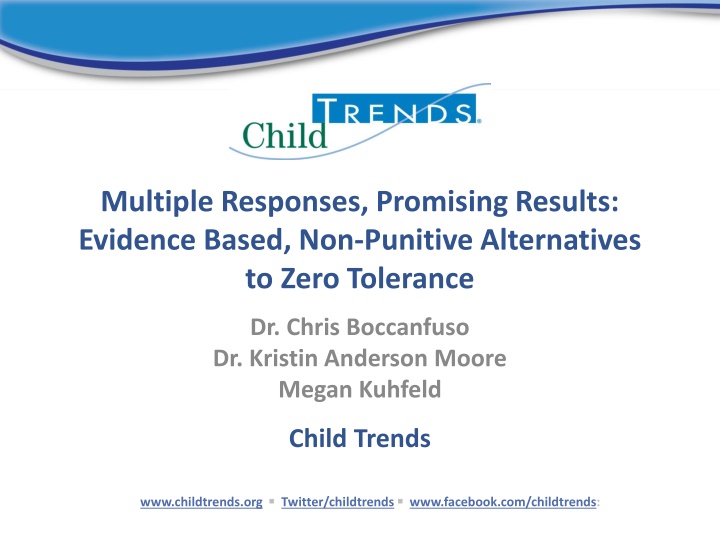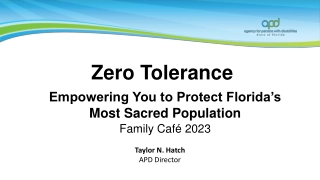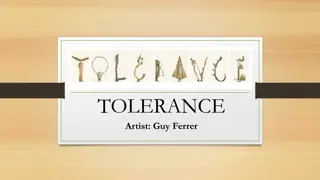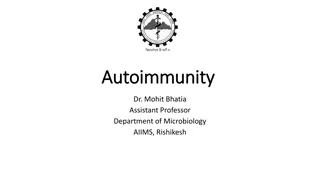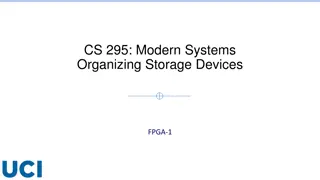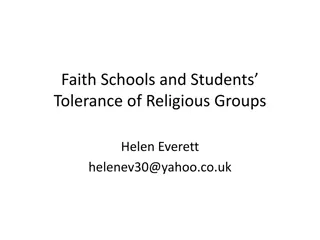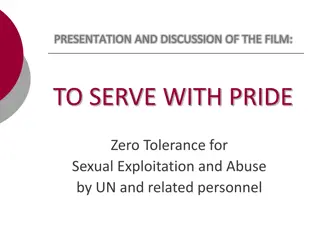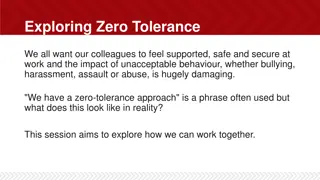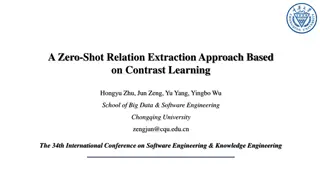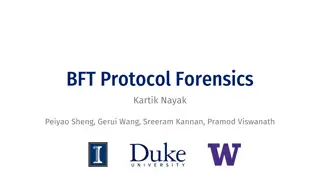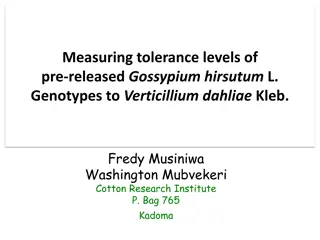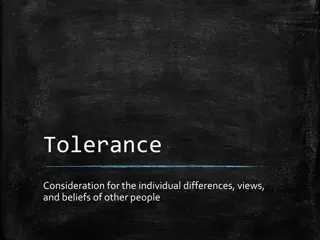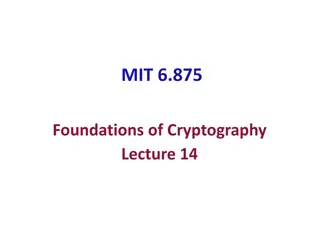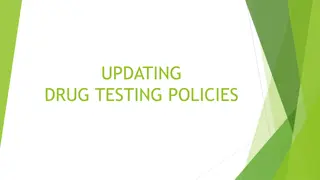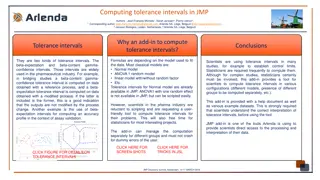Evidence-Based Alternatives to Zero Tolerance Policies
Zero tolerance policies in schools have not shown clear effectiveness and are associated with negative outcomes for students. Suspensions and expulsions linked to zero tolerance can lead to disconnection from school, risky behavior, poor academic achievement, and entry into the school-to-prison pipeline. Non-punitive alternatives, supported by research, offer promising solutions to improve student behavior and school safety.
Download Presentation

Please find below an Image/Link to download the presentation.
The content on the website is provided AS IS for your information and personal use only. It may not be sold, licensed, or shared on other websites without obtaining consent from the author.If you encounter any issues during the download, it is possible that the publisher has removed the file from their server.
You are allowed to download the files provided on this website for personal or commercial use, subject to the condition that they are used lawfully. All files are the property of their respective owners.
The content on the website is provided AS IS for your information and personal use only. It may not be sold, licensed, or shared on other websites without obtaining consent from the author.
E N D
Presentation Transcript
Multiple Responses, Promising Results: Evidence Based, Non-Punitive Alternatives to Zero Tolerance Dr. Chris Boccanfuso Dr. Kristin Anderson Moore Megan Kuhfeld Child Trends www.childtrends.org Twitter/childtrends www.facebook.com/childtrends:
How Have Zero Tolerance Policies been Implemented? In the wake of Columbine and other tragedies, many districts expanded zero tolerance to include fighting, illegal substances, disrespect, even banned clothing Roughly 80% of K-12 schools nationwide have expanded zero tolerance policies In 2006, more than 3.3 million students (1 in 14) were suspended or expelled - less than 10% for violent offense Evidence Based, Non-Punitive Alternatives to Zero Tolerance C. Boccanfuso, K.A. Moore Citations: 19,45,48-50,54 #
Have Zero Tolerance Policies Worked? The short answer is we don t know for sure, but it doesn t look like it Zero tolerance has not been evaluated using experimental research Non-experimental research is limited, but indicates that: Zero tolerance policies have not reduced the number of drug or violent offenses in schools Bullying, in particular, is still prevalent in most schools Enforcement of zero tolerance is extremely inconsistent in many schools Very young students subject to zero tolerance punishment Citations: 1,3,11,12,17,25-27,35,40,48,50-52,54,61,64 Evidence Based, Non-Punitive Alternatives to Zero Tolerance C. Boccanfuso, K.A. Moore #
Have Zero Tolerance Policies Worked? Suspension and expulsion 2 punishments associated with zero tolerance put students at risk for several negative outcomes: Less connection to school Greater participation in risky or illegal behavior Poor academic achievement and dropout Entry into the school to prison pipeline Suspension and expulsion are also related to poor school- wide climate and achievement, lower percentages of students school-wide characterizing school as safe Citations: 1,3,11,12,17,25-27,35,40,48,50-52,54,61,64 Evidence Based, Non-Punitive Alternatives to Zero Tolerance C. Boccanfuso, K.A. Moore #
If Zero Tolerance Doesnt Work, What Does? Several non-punitive policies and programs have been experimentally evaluated, and proven to improve student behavior and school safety Instead of relying mainly on punishment, these programs use one of two broad approaches: Use character education and social skill building to reduce the risk of violence and misbehavior Provide targeted behavioral supports for students who are at-risk for involvement in a serious incident Evidence Based, Non-Punitive Alternatives to Zero Tolerance C. Boccanfuso, K.A. Moore #
What Works: Character Education and Social-Emotional Learning Character education programs develop students character by teaching core values such as empathy, honesty, courage and kindness that are common across cultures Social-emotional learning programs help children acquire the knowledge, attitudes, and skills to: Recognize and manage their emotions Establish and maintain positive relationships Make responsible decisions Handle interpersonal situations effectively Evidence Based, Non-Punitive Alternatives to Zero Tolerance C. Boccanfuso, K.A. Moore Citations: 21,60 #
What Works: Character Education and Social-Emotional Learning Experimental evaluations of character education and social- emotional learning programs have found these programs: Positively impact social-emotional skills Improve behavior of at-risk students Reduce aggression and conflict problems Increase academic performance across age, race/ethnicity, and ability level Are more effective the longer students are in the program These programs have been implemented and evaluated most often at the elementary school level Evidence Based, Non-Punitive Alternatives to Zero Tolerance C. Boccanfuso, K.A. Moore Citations: 2,5,21,41,42,43,53,57-60 #
What Works: Character Education and Social-Emotional Learning The What Works Clearinghouse and Child Trends LINKS database (www.childtrends.org/links) has identified several programs that positively impact behavior, including Positive Action Too Good for Violence Connect with Kids Only a fraction of the hundreds of character education and social-emotional learning programs in schools today have been experimentally evaluated Evidence Based, Non-Punitive Alternatives to Zero Tolerance C. Boccanfuso, K.A. Moore Citations: 2,41,53,57,58 #
What Works: Targeted Behavioral Supports for At-Risk Students Targeted behavioral supports for at-risk students improve school safety by: Addressing the root causes of negative/violent behavior Providing students with the tools to deal with the specific sources of negative behavior Providing continuing training or mentoring for at-risk students throughout their academic career Evidence Based, Non-Punitive Alternatives to Zero Tolerance C. Boccanfuso, K.A. Moore #
What Works: Targeted Behavioral Supports for At-Risk Students Experimental evaluations of several targeted behavioral support programs found that many of these programs: Build social and emotional competencies Reduce the likelihood of drug and alcohol abuse Improve student behavior Reduce the number of repeat offenses, suspensions, and expulsions See Child Trends LINKS database for rigorous evaluations of targeted behavioral support programs programs Evidence Based, Non-Punitive Alternatives to Zero Tolerance C. Boccanfuso, K.A. Moore Citations: 13,15,22,23,39 #
What Works: Multi-Tiered Approaches to Discipline Multi-tiered approaches to discipline incorporate both preventative approaches and targeted behavioral supports Lowest tier aimed at all students Defining and teaching expectations for behavior Rewarding positive behavior In some cases, teach character education or social- emotional learning principles (e.g., empathy, communication skills) Upper tier(s) are targeted behavioral supports for students exhibiting problem behaviors Evidence Based, Non-Punitive Alternatives to Zero Tolerance C. Boccanfuso, K.A. Moore Citations: 7,28,38,40 #
What Works: Multi-Tiered Approaches to Discipline Several of these programs have been extensively researched, particularly Positive Behavioral Interventions and Supports (PBIS) Evaluations of multi-tiered approaches have found that these programs: Improve social behavior and social skills Reduce referrals for discipline problems Reduce aggressive behavior Improve academic outcomes Have lasting impacts Evidence Based, Non-Punitive Alternatives to Zero Tolerance C. Boccanfuso, K.A. Moore Citations: 4,8-10,20,29,30,32,33,37,40 #
Putting it all Together Disciplinary measures have a place in promoting a safe, supportive educational environment However, there is zero evidence that zero tolerance policies contribute to such an environment Non-experimental research suggests that zero tolerance is harmful to students, even those who are not subjected to zero tolerance punishment Evidence Based, Non-Punitive Alternatives to Zero Tolerance C. Boccanfuso, K.A. Moore #
Putting it all Together Several evidence based, non-punitive alternatives to zero tolerance improve student behavior, school safety, and in some cases academic performance: Character Education and Social Emotional Learning Targeted Behavioral Supports Multi-Tiered Approaches to Discipline These programs are more prevalent at the elementary level The number of non-punitive alternatives that are evidence- based is just the tip of the iceberg; many promising programs have not been evaluated Evidence Based, Non-Punitive Alternatives to Zero Tolerance C. Boccanfuso, K.A. Moore #
Questions? Please contact Dr. Kristin A. Moore with any questions about our Zero Tolerance findings Kristin A. Moore, PhD Senior Scholar, Child Trends 4301 Connecticut Avenue, NW Suite 350 Washington, DC 20008 Phone: 202-572-6002 kmoore@childtrends.org Evidence Based, Non-Punitive Alternatives to Zero Tolerance C. Boccanfuso, K.A. Moore #
Resources on Alternatives to Zero Tolerance Multiple Responses, Promising Results: Evidence Based, Non- Punitive Alternatives to Zero Tolerance http://www.childtrends.org/Files//Child_Trends- 2011_03_01_RB_AltToZeroTolerance.pdf Child Trends website www.childtrends.org Child Trends LINKS database of Evidence Based Practices http://www.childtrends.org/Links/ What Works Clearinghouse http://ies.ed.gov/ncee/wwc/ Collaborative for Academic Social and Emotional Learning (CASEL) www.casel.org Character Education Partnership www.character.org Evidence Based, Non-Punitive Alternatives to Zero Tolerance C. Boccanfuso, K.A. Moore #
References 1American Psychological Association Zero Tolerance Task Force. (2008). Are zero tolerance policies effective in the schools?: An evidentiary review and recommendations. American Psychologist, 63(9), 852-862. 2 Bacon, T. P. (2003). Technical report: The effects of the Too Good for Violence prevention program on student behaviors and protective factors. Tampa, FL: C. E. Mendez Foundation, Inc. . 3 Balfanz, R., & Boccanfuso, C. (2007). Falling off the Path to Graduation: Middle Grade Indicators in Boston. Baltimore, MD: Everyone Graduates Center (copies available upon request). 4 Barrett, S., Bradshaw, C., & Lewis-Palmer, T. (2008). Maryland state-wide PBIS initiative: Systems, evaluation, and next steps. Journal of Positive Behavior Interventions, 10, 105-114. 5 Berkowitz, M. W., & Bier, M. C. (2005). What works in charter education: A research driven guide for educators: Charter Education Partnership. 6 Blankstein, A. (1999, October 26). Parents, school officials talk about violence at Grant High; Hundreds pack auditorium at campus where tensions flared between Armenian and Latino students. Principal vows Zero Tolerance for fighting. Los Angeles Times, p. B2. 7 Bradley, R., Doolittle, J., Lopez, F., Smith, J., & Sugai, G. (2007). Discipline: Improved understanding and implementation. Paper presented at the OSEP Part B Regulations Regional Implementation Meeting: Building the Legacy IDEA 2004, Washington, DC. 8 Bradshaw, C., Koth, C., Bevans, K., Ialongo, N., & Leaf, P. (2008). The impact of school-wide positive behavioral interventions and supports (PBIS) on the organizational health of elementary schools. School Psychology Quarterly, 23, 462-473. 9 Bradshaw, C., Mitchell, M., & Leaf, P. (2010). Examining the effects of school-wide positive behavioral interventions and supports on student outcomes: Results from a randomized controlled effectiveness trial in elementary schools. Journal of Positive Behavior Interventions, 12(3), 133-148. 10 Bradshaw, C. P., Koth, C. W., Thornton, L. A., & Leaf, P. J. (2009). Altering school climate through school-wide Positive Behavioral Interventions and Supports: Findings from a group-randomized effectiveness trial. Prevention Science, 10(2), 100-115. 11 Bryk, A., & Schneider, B. (2002). Trust in Schools: A Core Resource for Improvement. New York, NY: Russell Sage Foundation. Evidence Based, Non-Punitive Alternatives to Zero Tolerance C. Boccanfuso, K.A. Moore #
References 12 Cauffman, E., & Steinberg, L. (2000). (Im)maturity of judgment in adolescence: Why adolescents may be less culpable than adults. Behavioral Sciences and the Law, 18, 741-760. 13 Child Trends. (2007). Cognitive-Behavioral Training Program for Behaviorally Disordered Adolescents. LINKS Database Retrieved October 5, 2010, from http://www.childtrends.org/Lifecourse/programs/CogBehTraining.htm 14 Child Trends. (2007). PeaceBuilders. LINKS Database Retrieved October 5, 2010, from http://www.childtrends.org/Lifecourse/programs/peacebuilders.htm 15 Child Trends. (2007). Reconnecting Youth. LINKS Database Retrieved October 5, 2010, from http://www.childtrends.org/Lifecourse/programs/ReconnectingYouth.htm 16 Child Trends. (2010). Positive Action Program. LINKS Database Retrieved October 5, 2010, from http://www.childtrends.org/Lifecourse/programs/pap.htm 17 Civil Rights Project, & Advancement Project. (2000). Opportunities Suspended: The Devastating Consequences of Zero Tolerance and School Discipline Policies. Paper presented at the National Summit on Zero Tolerance 18 Davis, J. E., & Jordan, W. T. (1994). The effects of school context, structure, and experiences on African American males in middle and high school. Journal of Negro Education, 63, 570-587. 19 DeVoe, J. F., Peter, K., Kaufman, P., Ruddy, S.A., Miller, A.K., Planty, M., Snyder, T.D., Duhart, D.T., & Rand, M.R. (2002). Indicators of School Crime and Safety. Washington, DC: U.S. Departments of Education and Justice. 20 Doolittle, J. (2006). Sustainability of positive supports in schools (unpublished dissertation). University of Oregon, Eugene, Oregon. 21 Durlak, J. A., & Weissberg, R. P. (2007). The impact of after-school programs that promote personal and social skills. Chicago, IL: Collaborative for Academic, Social, and Emotional Learning. 22 Eggert, L. L., Thompson, E. A., Herting, J. R., & Nicholas, L. J. (1995). Reducing suicide potential among high-risk youth: Tests of a school-based prevention program. Suicide & Life-Threatening Behavior, 25, 276-296. 23 Eggert, L. L., Thompson, E. A., Herting, J. R., Nicholas, L. J., & Dickers, B. G. (1994). Preventing adolescent drug abuse and high school dropout through an intensive social network development program. American Journal of Health Promotion, 8, 202-215. 11 , DC. Evidence Based, Non-Punitive Alternatives to Zero Tolerance C. Boccanfuso, K.A. Moore #
References 24 Flannery, D. J., Vazsonyi, A. T., Liau, A. K., Guo, S., Powell, K. E., Atha, H., et al. (2003). Initial behavior outcomes for the PeaceBuilders universal school-based prevention program. Developmental Psychology, 39(2), 292-308. 25 Gardner, M., & Steinberg, L. (2005). Peer influence on risk taking, risk preference, and risky decision making in adolescence and adulthood: An experimental study. Developmental Psychology, 41, 625-635. 26 Grisso, T., Steinberg, L., Woolard, J., Cauffman, E., Scott, E., Graham, S., & et al. (2003). Juveniles competence to stand trial: A comparison of adolescents and adults capacities as trial defendants. Law and Human Behavior Therapy, 27, 333-363. 27 Hooper, C., Luciana, M., Conklin, H., & Yarger, R. (2004). Adolescents performance on the Iowa Gambling Task: Implications for the development of decision making and ventromedial prefrontal cortex. Developmental Psychology, 2004(40), 1148-1158. 28 Horner, R., Sugai, G., & Anderson, C. M. (in press). Examining the evidence base for schoolwide positive behavior support. Focus on Exceptional Children. 29 Horner, R., Sugai, G., Smolkowski, K., Eber, L., Nakasato, J., Todd, A. W., et al. (2009). A randomized, wait-list controlled effectiveness trial assessing school-wide positive behavior support in elementary schools. Journal of Positive Behavioral Interventions, 11(133 144). 30 Horner, R., Sugai, G., Todd, A. W., & Lewis-Palmer, T. (2005). School-wide positive behavior support: An alternative approach to discipline in schools. In L. M. Bambara & L. Kern (Eds.), Individualized supports for students with problem behaviors. (pp. 359-390). New York: Guilford Press. 31 Larson, C. L., & Ovando, C. J. (2001). Racial conflict in a divided community: An illustrative case study of socio-political conflict. In C. L. Larson & C. J. Ovando (Eds.), The color of bureaucacy: The politics of equity in multicultural school communities (pp. 31-60). Belmont, CA: Wadsworth. 32 Lohrmann-O Rourke, S., Knoster, T., Sabatine, K., Smith, D., Horvath, G., & Llewellyn, G. (2000). School-wide Application of PBS in the Bangor Area School District. Journal of Positive Behavior Interventions, 2(4), 283-240. 33 Luiselli, J., Putnam, R., & Sunderland, M. (2002). Longitudinal evaluation of behavior support interventions in public middle school. Journal of Positive Behavior Interventions, 4(3), 182-188. Evidence Based, Non-Punitive Alternatives to Zero Tolerance C. Boccanfuso, K.A. Moore #
References 34 McNeely, C. A., Nonnemaker, J. M., & Blum, R. W. (2002). Promoting school connectedness: Evidence from the National Longitudinal Study of Adolescent Health. Journal of School Health, 72, 138-146. 35 Melton, G. B., Limber, S.P., Cunningham, P., Osgood, D.W., Chambers J., Flerx, V., Henggeler S., & Nation, M. . (1998). Violence Among Rural Youth. Final Report to the Office of Juvenile Justice and Deliquency Prevention. 36 Morrison, G. M., & D'Incau, B. (1997). The Web of Zero-Tolerance: Characteristics of Students Who Are Recommended for Expulsion from School. Education and Treatment of Children, 20(3), 316-335. 37 Muscott, H. S., Mann, E., Benjamin, T. B., Gately, S., Bell, K. E., & Muscott, A. J. (2004). Positive behavioral interventions and supports in New Hampshire: Preliminary results of a statewide system for implementing schoolwide discipline practices. . Education and Treatment of Children, 27, 453-475. 38 National Research Council and the Institute of Medicine. (2004). Engaging schools. Washington, D.C.: The National Academies Press. 39 NREPP. (2010). Reconnecting Youth: A Peer Group Approach to Building Life Skills. NREPP: SAMHSA's National Registry of Evidence-based Programs and Practices Retrieved October 5, 2010, from http://www.nrepp.samhsa.gov/ViewIntervention.aspx?id=96 40 Osher, D., Bear, G. G., Sprague, J. R., & Doyle, W. (2010). How Can We Improve School Discipline? Educational Researcher, 39(1), 48-58. 41 Page, B., & D Agostino, A. (2005). Connect with Kids: 2004-2005: Study Results for Kansas and Missouri. Durham, NC: Compass Consulting Group. 42 Payton, J., Weissberg, R. P., Durlak, J. A., Dymnicki, A. B., Taylor, R. D., Schellinger, K. B., et al. (2008). The positive impact of social and emotional learning for kindergarten to eighth-grade students: Findings from three scientific reviews. Chicago, IL: Collaborative for Academic, Social, and Emotional Learning. 43 Person, A. E., Moiduddin, E., Hague-Angus, M., & Malone, L. M. (2009). Survey of outcomes measurement in research on character education programs. Washington, DC: National Center for Educational Evaluation and Regional Assistance, Institute of Education Sciences, U.S. Department of Education. 44 Planty, M., Hussar, W., Snyder, T., Kena, G., KewalRamani, A., Kemp, J., Bianco, K., Dinkes, R. (2009). The Condition of Education 2009 (NCES 2009-081). National Center for Education Statistics, Institute of Education Sciences, U.S. Department of Education. Washington DC Evidence Based, Non-Punitive Alternatives to Zero Tolerance C. Boccanfuso, K.A. Moore #
References 45 Phillips, R. (2010). Toy gun leads to Florida boy's expulsion. Retrieved October 10, 2010, from http://www.cnn.com/2010/US/10/06/toy.gun.expelled/index.html?hpt=T1 46 Potts, K., Njie, B., Detch, E. R., & Walton, J. (2003). Zero tolerance in Tennessee schools: An update. Nashville, TN: Tennessee State Controller of the Treasury, Office of Educational Accountability. 47 Public Agenda. (2004). Teaching interrupted: Do discipline policies in today s public schools foster the common good? Retrieved September 20, 2010, from http://www.publicagenda.org/files/pdf/teaching_interrupted.pdf. 12 48 Raffaele Mendez, L. M., & Knoff, H. M. (2003). Who gets suspended from school and why: A demographic analysis of schools and disciplinary infractions in a large school district. Education & Treatment of Children, 26(30-51). 49 Skiba, R. (2000). Zero Tolerance, Zero Evidence: An Analysis of School Disciplinary Practice. Bloomington, IN: Education Policy Center Indiana University. 50 Skiba, R., & Rausch, M. K. (2004). The Relationship between Achievement, Discipline, and Race: An Analysis of Factors Predicting ISTEP Scores. Bloomington, IN: Center for Evaluation and Education Policy. 51 Skiba, R., & Rausch, M. K. (2006a). Zero tolerance, suspension, and expulsion: Questions of equity and effectiveness. In C. M. Evertson & C. S. Weinstein (Eds.), Handbook of classroom management: Research, practice, and contemporary issues (pp. 1063-1089). Mahwah, NJ: Lawrence Erlbaum Associates. 52 Skiba, R., & Raush, M. K. (2006b). School disciplinary systems: Alternatives to suspension and expulsion. In G. G. Bear & K. M. Minke (Eds.), Children's Needs III: Development, Prevention, and Intervention. Bethesda, MD: National Association of School Psychologists. 53 Social and Character Development Research Consortium. (2010). Efficacy of Schoolwide Programs to Promote Social and Character Development and Reduce Problem Behavior in Elementary School Children. Washington, DC: National Center for Education Research, Institute of Education Sciences, U.S. Department of Education. Evidence Based, Non-Punitive Alternatives to Zero Tolerance C. Boccanfuso, K.A. Moore #
References 54 Stop Bullying Now. Tip Sheets: Misdirections in Bullying Prevention and Intervention. Retrieved December 27, 2010, from http://www.stopbullyingnow.hrsa.gov/adults/tip-sheets/tip-sheet-05.aspx 55 U.S. Department of Education, & Office of Safe and Drug-Free Schools. (2007). Report on the Implementation of the Gun- Free Schools Act in the States and Outlying Areas, School Year 2003 04, . Washington, D.C. 56 Vazsonyi, A. T., Belliston, L. M., & Flannery, D. J. (2004). Evaluation Of A School-Based, Universal Violence Prevention Program: Low-, Medium-, and High-Risk Children. Youth Violence and Juvenile Justice, 2(2), 185-206. 57 What Works Clearinghouse. (2006). Connect with Kids. Washington, DC: U.S. Department of Education, Institute of Education Statistics. 58 What Works Clearinghouse. (2006). Too Good For Violence. Washington, DC: U.S. Department of Education, Institute of Education Statistics. 59 What Works Clearinghouse. (2007). Positive Action. Washington, DC: U.S. Department of Education, Institute of Education Statistics. 60 What Works Clearinghouse. (2007). WWC Topic Report: Character Education: U.S. Department of education, Institute for Education Sciences. 61 Whitlock, J. (2006). Youth Perceptions of Life at School: Contextual Correlates of School Connectedness in Adolescence. Applied Developmental Science, 10(1), 13-29. 62 Wu, S. C., Pink, W. T., Crain, R. L., & Moles, O. (1982). Student suspension: A critical reappraisal. Urban Review, 14, 245- 303. 63 Youth United for Change & Advancement Project. (2011). Zero Tolerance in Philadelphia: Denying Educational Opportunities and Creating a Pathway to Prison. Philadelphia: Authors. 64 Steinberg, M.P., E. Allensworth, & D.W. Johnson. (2011). Student and Teacher Safety in Chicago Public Schools: The Roles of Community Context and Student Social Organization. Chicago: Consortium on Chicago School Research. Evidence Based, Non-Punitive Alternatives to Zero Tolerance C. Boccanfuso, K.A. Moore #
